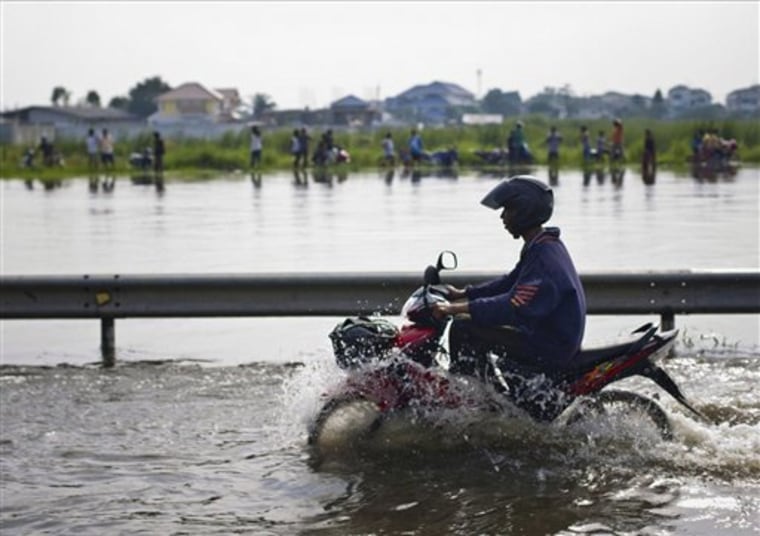Floodwaters have begun seeping into Bangkok's outer districts, one day after the government opened several key floodgates in a risky bid to let built-up water flow through the capital's canals toward the sea.
An Associated Press team saw water entering homes in the northern Lak Si district, which is located along the city's main Prapa canal.
Water in the area has risen to knee-level in some places, but damage has so far been minor and has not affected Bangkok's main business district.
The government had predicted canals could overflow, but it is still unknown to what degree.
Gov. Sukhumbhand Paribatra said Friday he was worried about inundation in the area and vast pools of runoff draining toward the capital are expected to intensify.
The sun was shining over the capital on Friday after some heavy rain the previous evening. The weather was expected to be generally clear over the weekend.
The government has been struggling to deal with the worst flooding in 50 years.
After trying to hold the line for a week, the government decided to open some canals on Thursday to allow water to run through the inner city.
Under fireThe government's flood crisis center said people in parts of Don Muang and Laksi districts, in northern Bangkok, should move belongings to higher floors. The crisis center is itself located in the old city airport in Don Muang.
Prime Minister Yingluck Shinawatra has come under fire for her management of the crisis, which was building even before she took office in early August and looks set to cost industry more than $3 billion and will hit economic growth.
Soldiers have played an active role in shoring up dikes and helping people relocate and, with Bangkok in danger, Yingluck has put an additional 50,000 armed forces personnel and 30,000 police on standby to help in relief work.
But she is resisting calls to invoke a state of emergency, which would mean deploying the army on the streets.
"It would ruin investors' confidence, which is quite weak already," Yingluck told reporters at the crisis center.
"At this moment we can see that we (the government and the people) are cooperating very well to help us get through the problem. If I declare a state of emergency, I would be telling the world that we can't help each other," she added.
Flood barriers breachedThe government's effort to guide the water around the east and west of the capital has had some success.
"This mission was intended to divert water out of Rapipat Canal and it has succeeded in pushing out water to the open sea faster," the crisis center said in a statement.
But water now covers a third of Thailand's provinces, some 4 million acres in the north, northeast and center of the country.
The flooding has killed at least 342 people since July and has devastated industrialized areas to the north of Bangkok.
A seventh big industrial estate was overwhelmed late on Thursday when flood barriers at the Bang Kadi park in Pathum Thani province about 30 miles north of the capital were breached.
The central bank put the damage to industry at more than 100 billion baht ($3.3 billion) on Thursday.
